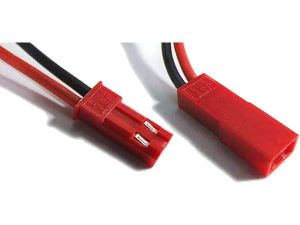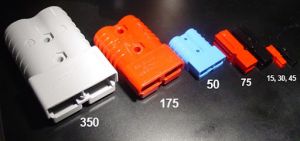Connectors
Jump to navigation
Jump to search
Why Connectors?
Bunny of Team Malice has created a great connector guide.
Although some people may soldier their batteries directly into their bots, nearly everyone uses connectors so they can unplug their batteries for easy charging. There are a lot of factors that go into deciding what the right connectors are for your application. All of the connectors mentioned below are suitable for Robot Combat but size, weight, current capacty and the physical security are all important to consider when deciding which one is right for you.
Terminology
- Male and Female connectors: Many connectors have a 'Male' connector type and a 'Female' connector type. There are a few reasons for this design approach. The connectors on the power-source side (battery) are typically 'Female' which means they receive the 'Male' connector which houses the electrical contacts inside the connector. This reduces the likelihood of the battery short circuiting by accident.
- Polarized: Many connectors are not symetrical which means they will only plug into each other in one direction. This ensures that the postive and ground sides of the battery are not accidentaly reversed.
- Crimped / Soldiered: Wires need to be secured to the connector. This can be done physically with a crimp or by soldering the wire to the connector. In some connectors the wire can be both crimped and soldiered.
- Anti-Spark: At higher voltages, electriicy can arc across the connector. This can result in carbon build-up on the connectors which reduces their efficiency. In worst-cases this electrical arc can damage electronics. Some connectors are designed to reduce this effect. Although anti-sparc connectors can be more expensive, they are typically a better choice at high voltages.
Connector Types
- JST: These small connectors work well in small robots but they have a limited current capacity. Some connectors come with 22 or higher gage wire. Look for ones that have at least 20 gage wire which will easily handle 5 amps. Also, these connectors don't make a strong physical connection and should be physically secured with tape or a zip-tie. Most smaller lipo batteries come with JST connecters by default.
- XT Connectors: This connector style is popular because of its fairly compact form factor and ability to handle high current. XT connectors come in 30,60, and 90 amp versions but can handle more than their rated current for short periods of time. Additionally the XT connectors come in anti-spark versions which are especially useful in high voltage applications. Most XT connectors will require that you soldier a wire to the connector. The connectors have a fair amount of thermal mass which can require a bit of practice with a quality soldering iron to make a good connection.
- Anderson PowerPoles: This older style connector is still very popular and comes in a range of physical sizes that are rated to handle between 15 and 350 amps. These connectors also have the advantage of a strong physical connection when plugged in. Although you can solder wires into these connectors, they are designed to be crimped.
- Bullet: These connectors come in various sizes to handle different current. One advantage is that they take up very little space but their physical connection can be weak in many cases. Like other connctors, scuring them with tape will help prevent power loss during a match.


